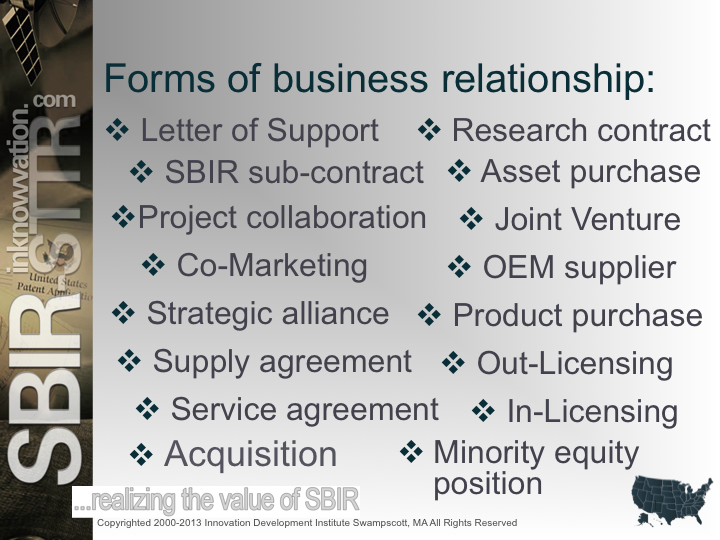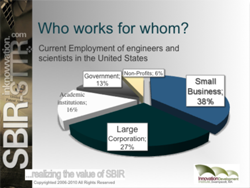 TechSeeker Registry®
TechSeeker Registry®
To our knowledge, this
systematic compilation of those large and mid-sized firms - what we call here
Tech Seekers - which have/ have had working relationship(s) with one/more SBIR-STTR involved firm is the only one of its type. That assumed, this is a unique - and potentially very valuable resource - to those who understand best how to use it.
- particularly among the primes - have been longtime SBIR associated and have a wide range of SBIR-STTR connections. Others have multiple different relationships over time with the same SBIR awardee; while still others having some form of relationship with a considerable number of different awardees. A few - but growing number - have all of the above. As the scope of what SBIRis about h
significantly in type and form, extent and longevity. Some Tech Seekers - particularly among the primes - have been longtime SBIR associated and have a wide range of SBIR-STTR connections. Others have multiple different relationships over time with the same SBIR awardee; while still others having some form of relationship with a considerable number of different awardees. A few - but growing number - have all of the above. As the scope of what - See more at: /home/techseeker-registry#sthash.EBSbXnnM.dpuf
significantly in type and form, extent and longevity. Some Tech Seekers - particularly among the primes - have been longtime SBIR associated and have a wide range of SBIR-STTR connections. Others have multiple different relationships over time with the same SBIR awardee; while still others having some form of relationship with a considerable number of different awardees. A few - but growing number - have all of the above. As the scope of what - See more at: /home/techseeker-registry#sthash.EBSbXnnM.dpuf
 Forms of relationship
Forms of relationship:
Tech Seeker-SBIR Awardee working relationships vary significantly in type and form, extent and longevity. Some Tech Seekers - particularly among the primes - have been longtime SBIR associated and have a wide range of SBIR-STTR connections. Others have multiple different relationships over time with the same SBIR awardee; while still others having some form of relationship with a considerable number of different awardees. A few - but growing number - have all of the above. As the scope of what SBIRis about has become better understood across a broader range of industry space, we see far more Tech Seekers new to the space and to the opportunity being added all the time. Though the extent and form of involvement is very different, the data already shows clearly that just about every major corporation and a significant percentage of mid-sized firms has - or has had - some form of working relationship with SBIR-STTR-involved firms. In some cases - particularly where the relationship was formed earlier on in the life of the program - it is evident that the SBIR involvement of the smaller firm was not at all a factor in that working relationship having been established. In these instances, it is apparent that those involved in the larger firm often have no idea that there even is SBIR connection. They are often actually quite surprised when they are made aware of that fact. More recently, however, it is striking that, particularly as they are being exposed to the diversity and depth that is the SBIR talent pool, in their role as Tech Seeker in an increasing number of larger firms it is becoming an important part of someone's job description actively to seek out firms which are SBIR-STTR involved. Not only does the extent and form of the small firm's SBIR involvement serve to validate their competencies but, not trivially, in an increasing number of instances, properly engaged, SBIR dollars can be a useful supplement to the resource availability of the larger firm, often enabling and supporting work which might otherwise be below their own payoff line.
It's all about what the Tech Seeker is looking for:
With the primary focus on
- what the Tech Seeker is looking for - a market pull, needs-driven approach
- versus the technology-push of trying to place what the small firm has
making the appropriate connections between the
right players in both the small firm and the large is at the heart and effectiveness of the ASSET system.
 Sorting the wheat from the chaff
Sorting the wheat from the chaff:
Ironically, the sheer depth and diversity of the demonstrated talent pool is both the attraction of SBIR to the Tech Seeker and also their greatest concern. With now over 19,000 firms having been SBIR involved - and a steady stream of firms new to the program every year - even addressing only those firms currently and/or recently SBIR involved - some 6500 small firms - can be a huge challenge. Just keeping track of who is doing what in the SBIR community, knowing who is any good and, even more critically, being able to find what they want when they want it, is bringing more and more large firm Tech Seekers to this site and to the ASSET system.
 What is driving large(r) firm SBIR interest?
What is driving large(r) firm SBIR interest?
Following the talent
Few corporations in the modern context maintain the major corporate R&D facilities which for preceding decades almost defined corporate operations. Substantially down-sized, most in-house research activity is far more applications-specific and focused primarily to addressing core capabilities and current product concerns. Across almost all industry segmens it is a rare larger firm that does not now meet some of its new product/new markets and non-core capability needs by reaching outside its own walls - a process which, though very different in different companies, is often collectively referred to as Open Innovation.
Initially, that external focus took the large firms to the universities - and many continue to maintain ongoing academic connection to these very useful centers of research competence. However, some of the type of working relationships they seek are not readily available from the university. Even more critically, important shifts in the labor markets - particularly who the technically trained now work for - have brought more large firms to the small firm door ... and, more particularly, to that of the SBIR awardee. As the attached pie chart shows, currently some 38 percent of all graduate trained engineers and scientists in the US now work for small firms versus 27 percent employed by the large corporations themselves with only 16 percent working in the university setting.
Our analysis of the compiled employee bios which are part of the databases show that SBIR firms - past and present - now employ almost 500,000 graduate trained engineers and scientists. Factoring to almost three-times as many as those similarly trained employed in the academic setting, this makes SBIR arguably the largest concentration of technical talent. It is not unreasonable to suggest that Tech Seekers are simply following the talent.
The ASSET system - on- and offline - serves well to provide structure to this process.


 TechSeeker Registry®
TechSeeker Registry® Forms of relationship:
Forms of relationship:  Sorting the wheat from the chaff:
Sorting the wheat from the chaff: What is driving large(r) firm SBIR interest?
What is driving large(r) firm SBIR interest?